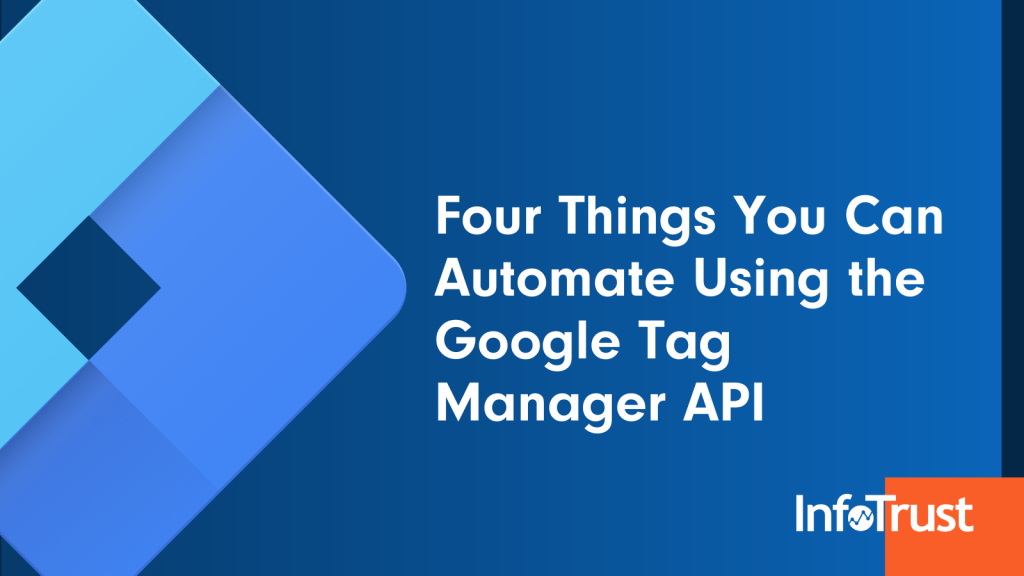If you are a CPG (Consumer-Packaged Goods) organization, or simply a company with multiple brands/markets/locations, you may have tens, hundreds, or even thousands of GTM containers. What if you need to deploy a marketing tag to 50 separate GTM containers? Doing this manually could take hours (if not days) to complete, and the risk of human error could cause a tag to misfire or contain invalid information. This erroneous data collection could lead to your business making poor decisions based on this “bad data”.
In this article, I will be showing a few scenarios where you can use the Google Tag Manager (GTM) API to quickly perform large-scale deployments, audits, and other useful tasks. While this article will not be a technical guide on how to use the Google Tag Manager API, it will hopefully give you some ideas of what it is capable of doing.
1. Create or update multiple tags across a large number of containers
By using the GTM API, you can write a script that will create a tag or set of tags under multiple containers. This can be done in minutes, and much of the script can be reused for future deployments as your organization adds new brand websites, changing tag details as needed. This also ensures that all deployments are consistent and done nearly simultaneously. You can schedule deployments to make sure that GTM tag additions are reflected on your various websites at the same time.
You can also utilize the API to make changes to existing tags/triggers/variables. Let’s say, for example, you have social media tags set to fire on specific landing pages, and the URLs happen to change. You can write a script that will hook into the API to modify all the triggers at one time. As a result, you can rest assured that any global tags you have firing across all your market/brand websites will continue collecting accurate data in the event of any changes.
2. Perform an audit of the tags in your container(s)
A GTM container can very quickly become full with so many tags/triggers/variables that it is difficult to navigate and manage. For single-website organizations, this can be a headache, but for a CPG or multi-brand organization with hundreds or thousands of GTM assets, it can be a nightmare. One feature of the GTM API is the ability to list out tags/triggers/variables. This allows you to export a spreadsheet in an easy-to-read format that you can share with appropriate business units to determine if a tag is still needed or up-to-date. It’s incredibly useful for GTM container cleanup.
3. Pull a list of users and their access levels
This same API list method allows you to pull out a user list of your containers (at the account or container level). This is great if you need a format that you can easily copy+paste with. You could schedule this to run once a week and email the results for someone to review and determine if any users were invited erroneously.
User audits are incredibly important for large CPG organizations. With potentially hundreds or thousands of GTM assets, you don’t want unnecessary users to have access to your accounts. The API makes it easy to pull a full list of users who have access, and you can use that list to programmatically clean up the users who should be removed.
4. Download and store backups of your GTM container
It’s good practice to occasionally export a JSON file of your container. While there are previous versions in the GTM interface, if something happens and you lose access to the container (for instance, it was created/managed by a third party agency that you are no longer working with) then you will have a backup of the previous tags/triggers/variables that were in the GTM container prior to you losing access. If this were to happen and you do not have a backup, there’s no way to know what tags/triggers/variables were in your GTM container.
You can also schedule a GET request that will download a JSON and store it somewhere on a server or storage device of your choice. You can run this daily, weekly, monthly, or whatever you feel is necessary for your organization.
With hundreds or thousands of GTM assets across their portfolio of brand/market websites, global CPG & Multi-brand organizations have unique tagging setups that can be impossible to implement or manage manually. Luckily, the Google Tag Manager API can help these massive organizations overcome some of these challenges by offering programmatic solutions to help accomplish some of the most common, redundant tasks associated with GTM tag/container management. While this article barely scratches the surface of what you are able to automate using Google’s API, we hope that it gives you some idea of just how powerful the GTM API can be for your organization.
Here at InfoTrust, we have a full automation team with extensive knowledge of the subject. If you feel that you are struggling to maintain your Google Tag Manager containers for your growing business, we excel at developing strategies for large CPG organizations. If you have any questions, I encourage you to please contact us!


